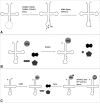Classification, diagnosis and potential mechanisms in pontocerebellar hypoplasia
- PMID: 21749694
- PMCID: PMC3159098
- DOI: 10.1186/1750-1172-6-50
Classification, diagnosis and potential mechanisms in pontocerebellar hypoplasia
Abstract
Pontocerebellar Hypoplasia (PCH) is group of very rare, inherited progressive neurodegenerative disorders with prenatal onset. Up to now seven different subtypes have been reported (PCH1-7). The incidence of each subtype is unknown. All subtypes share common characteristics, including hypoplasia/atrophy of cerebellum and pons, progressive microcephaly, and variable cerebral involvement. Patients have severe cognitive and motor handicaps and seizures are often reported. Treatment is only symptomatic and prognosis is poor, as most patients die during infancy or childhood. The genetic basis of different subtypes has been elucidated, which makes prenatal testing possible in families with mutations. Mutations in three tRNA splicing endonuclease subunit genes were found to be responsible for PCH2, PCH4 and PCH5. Mutations in the nuclear encoded mitochondrial arginyl- tRNA synthetase gene underlie PCH6. The tRNA splicing endonuclease, the mitochondrial arginyl- tRNA synthetase and the vaccinia related kinase1 are mutated in the minority of PCH1 cases. These genes are involved in essential processes in protein synthesis in general and tRNA processing in particular. In this review we describe the neuroradiological, neuropathological, clinical and genetic features of the different PCH subtypes and we report on in vitro and in vivo studies on the tRNA splicing endonuclease and mitochondrial arginyl-tRNA synthetase and discuss their relation to pontocerebellar hypoplasia.
Figures


References
-
- Brun R. Zur Kenntnis der Bildungsfehler des Kleinhirns. Epikritische Bemerkungen zur Entwicklungspathologie, Morphologie und Klinik der umschriebenen Entwicklungshemmungen des Neozerebellums. Schweiz Arch Neurol Psychiatr. 1917;1:48–105.
-
- Brouwer B. Hypoplasia ponto-neocerebellaris. Psychiatr Neurol (Amsterdam) 1924;6:461–469.
-
- Koster S. Two cases of hypoplasia ponto-neocerebellaris. Acta Psychiatr (Københ) 1926;1:47–76. doi: 10.1111/j.1600-0447.1926.tb05648.x. - DOI
-
- Krause F. Über einen Bildungsfehler des Kleinhirns und einige faseranatomische Beziehungen des Organs. Zeitschrift der Gesammten Neurologie und Psychiatrie. 1928;119:788–815.
-
- Biemond A. Hypoplasia ponto-neocerebellaris, with malformation of the dentate nucleus. Folia Psychiatr Neurol Neurochir Neerl. 1955;58:2–7. - PubMed
Publication types
MeSH terms
Substances
Supplementary concepts
LinkOut - more resources
Full Text Sources
Other Literature Sources
Medical

